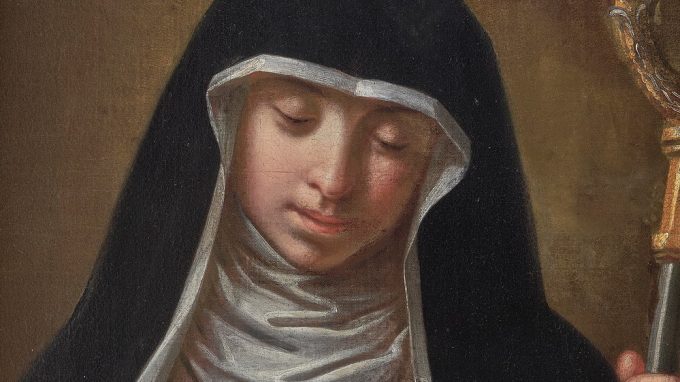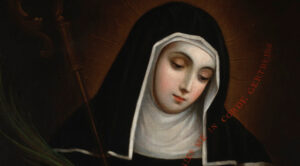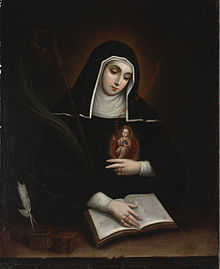
St. Gertrude was a gifted cloistered nun, scholar, and mystic. Nothing is known of her family, but she was born in Thuringia (in the Holy Roman Empire) in 1256. She was but five years old when she arrived, either orphaned or left with relatives, at the Benedictine Cistercian monastery at Helfta in Saxony (present day Eisleben in central Germany). The monastery was guided by its Abbess, Gertrude of Hackerborn. The Abbess was exceptional in her talents, having served as an abbess since the age of nineteen. Through her able leadership, the monastery was renowned throughout the Holy Roman Empire for its nuns’ high education and deep spirituality. The young child Gertrude was entrusted to the care of the Abbess’s sister [St.] Mechtild, who governed the monastery’s children and who was herself a mystic. A mystic is someone who experiences direct union of the human soul with Divinity. The child was an eager learner at the monastery and became proficient in Scripture, Latin literature, and the written works of great Doctors of the Church Sts. Augustine, Gregory Nazianzen and Bernard of Clairvaux. With time, young Gertrude and Mechtild developed a close friendship.
LIFE CHANGING VISIT FROM JESUS

When she was twenty-six, Gertrude experienced her first of many apparitions of Jesus, with Whom she became enraptured. With the same zeal with which she applied herself to her studies, Gertrude devoted herself to her extraordinary relationship with Jesus. When in a rapture, she was seemingly in an unseen world, insensitive to everything around her. Yet she lived the life of an ordinary nun. She was known to have received the Eucharist directly from an angel or from Jesus Himself. He appeared to her daily for more than twenty years. He revealed to her a well-known prayer which would obtain release for one thousand souls from Purgatory. On occasion, she was able to see her own guardian angel bear her prayers up to the heavenly throne. Also known to appear to her were Sts. John the Apostle, Agnes, and Benedict. The Benedictines were and are known for keeping St. Benedict’s laws regarding welcoming visitors as if they were Christ. As a nun, Gertrude was known for her unending charity for the poor, yet her counsel was sought by rich and poor alike. She had a particular sympathy for the suffering souls in purgatory and devoted herself to prayer on their behalf. She understood the value of the sacrificial life of consecrated religious and lived as an example of someone who always strives to be pleasing to God because of her great love for Him. She also possessed the gifts of miracles and of prophecy.
In 1291, the Abbess died, and seven years later, Gertrude’s dear mentor and friend Mechtild also died. Gertrude had tended to both women during their time of declining health. Her own health was also declining, but that did not make a change in her daily devotion to God. She died November 17, 1302 at Helfta. She was forty-six years old. It is believed that she was buried with her Abbess Gertrude and with Mechtild, but the whereabouts of the remains are unknown. The monastery was destroyed in the fourteenth century, rebuilt, then closed and used for secular purposes beginning in the sixteenth century. Amazingly, it was again obtained in the 1990’s by the Diocese of Magdeburg, which had it restored and given for use of Cistercian nuns.
LEGACY OF ST. GERTRUDE

St. Gertrude’s legacy is her written account of her mystical experiences, all written in Latin. She carefully recorded what transpired during the mystical visits, so that what she was so blessed to experience could be of benefit to her religious sisters. The Book of Extraordinary Grace (also known as The Revelation of St. Gertrude or The Herald of Divine Love) contains a five-part discourse. Only part two was written by Gertrude herself, the others being written by unknown Cistercian collaborators. Gertrude and Mechtild together composed numerous prayers. Gertrude also recorded Mechtild’s mystical experiences in Liber Specialis Gratiae. Most noteworthy is Gertrude’s great devotion to the Sacred Heart of Jesus, four centuries before Jesus revealed this devotion to St. Margaret Mary Alacoque. After her death, the superiors of her order had the writings studied by Franciscan and Dominican theologians, who unanimously approved. Although she was never formally canonized, a feast in remembrance of her was established for the universal Church in 1677, the equivalent of canonization. To distinguish her from her Abbess, also named Gertrude, she was given the title Gertrude the Great by Pope Benedict XIV to indicate her tremendous theological understanding. One of the most important of the many medieval mystics, St. Gertrude’s feast day is November 16.
